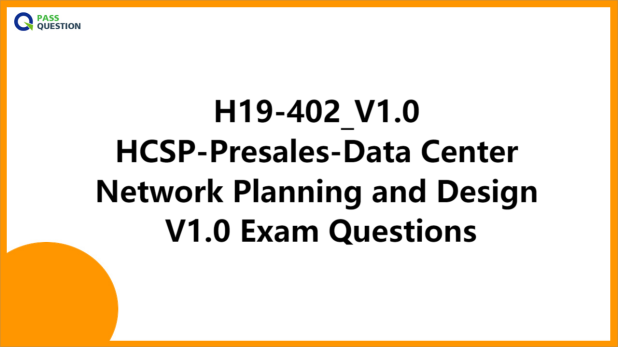Preparing for the H19-402_V1.0 HCSP-Presales-Data Center Network Planning and Design V1.0 exam can be a challenging task, but utilizing PassQuestion H19-402_V1.0 HCSP-Presales-Data Center Network Planning and Design V1.0 Exam Questions can significantly enhance your study process. PassQuestion offers a comprehensive set of H19-402_V1.0 questions and answers that cover the entire exam syllabus. Each question is designed to reflect the format and difficulty level of the actual exam, providing candidates with an authentic preparation experience. By studying these H19-402_V1.0 HCSP-Presales-Data Center Network Planning and Design V1.0 Exam Questions, you can build confidence and increase your chances of passing the Huawei H19-402_V1.0 exam with flying colors.

HCSP-Presales-Data Center Network Planning and Design Certification
Passing the HCSP-Presales-Data Center Network Planning and Design V1.0 certification proves that you can build Data Center Network Solutions, independently operate projects, conduct solution technical communication, identify customer pain points, develop appropriate solutions, and have strong competitive analysis and quotation capabilities. This certification is for the pre-sales professionals of partners who sell Huawei enterprise Data Center Network products and Data Center Network solutions, and those who want to obtain the HCSP-Presales-Data Center Network Planning and Design V1.0 certification.
H19-402_V1.0 Exam Information
Certification Name: HCSP-Presales-Data Center Network Planning and Design
Exam Code: H19-402
Exam Name: HCSP-Presales-Data Center Network Planning and Design V1.0
Language: English/Chinese
Fee: 100 USD
Duration: 90 minutes
Pass Score/Total Score: 600/1000
Exam Format: Single-answer Question, Multiple-answer Question, True or false
Huawei H19-402_V1.0 Exam Knowledge Points
Data Center Network Overview 16%
- DC and DCN overview
- Terms and key technologies of DCs
Technical Fundamentals of Data Communications Networks 9%
- Basics of Ethernet switching
- Network reachability
- Network reliability
- Network service and management
- Network security
- VPN
VXLAN and BGP EVPN 10%
- Overview of VXLAN and DCN virtualization
- Basic concepts of VXLAN
- VXLAN fundamentals
- Application of VXLAN on DCNs
M-LAG 9%
- Overview of M-LAG
- Fundamentals of M-LAG
- M-LAG failure protection
- M-LAG deployment scenarios
Intelligent Lossless Data Center Network 8%
- Data center network in the era of intelligence
- Key technical principles of intelligent lossless Ethernet networks
- Typical networking
Huawei CloudFabric Solution 17%
- Basic concepts of Huawei CloudFabric solution
- Architecture and functions of Huawei CloudFabric solution
- Components of Huawei CloudFabric solution
Four CloudFabric Service Automation Scenarios and Related Solutions 4%
- Overview of the four CloudFabric service automation scenarios
- Service automation scenarios of CloudFabric: network virtualization – hosting, network virtualization – computing, cloud-network integration – OpenStack, and Kubernetes container network
iMaster NCE-Fabric 6%
- Introduction to iMaster NCE-Fabric
- Key functions of iMaster NCE-Fabric
- Installation and deployment, reliability, and openness of iMaster NCE-Fabric
CloudFabric Underlay and Overlay Network Design 7%
- Underlay network design
- Overlay network design
- High reliability design of a physical network
Typical DCN Design Guide 11%
- DCN overview
- DCN planning and design methods
- Typical DCN design case
Intelligent O&M of the CloudFabric Solution 3%
- Overview of CloudFabric intelligent O&M
- iMaster NCE-Fabric O&M functions
- iMaster NCE-FabricInsight O&M functions
View Online HCSP-Presales-Data Center Network Planning and Design V1.0 H19-402_V1.0 Free Questions
1. Which of the following statements is false about the Multi-PoD scenario in CloudFabric solution?
A. Multi-PoD is also called a remote controller cluster solution.
B. One copy of iMaster NCE-Fabric is used to manage multiple data centers.
C. Two iMaster NCE-Fabric clusters can be remotely deployed in active/standby mode.
D. Both the active and standby controller clusters in the Multi-PoD solution are running and processing services.
Answer: D
2. Which of the following roles is used for interconnection between different data centers?
A. Service leaf
B. DCI gateway
C. Border leaf
D. Spine
Answer: B
3. Which of the following is not an interconnection solution supported in the CloudFabric open ecosystem?
A. Third-party virtualization platform interconnection solution
B. Container platform interconnection solution
C. Third-party VAS interconnection solution
D. Third-party security controller interconnection solution
Answer: D
4. What is the function of an OVSDB interface in the CloudFabric solution?
A. vSwitches use the OVSDB interface to establish a connection with the controller and report its status and alarms.
B. The OVSDB interface is used to exchange dynamic configurations with vSwitches.
C. The OVSDB interface is used to deliver flow tables to vSwitches.
D. vSwitches use the OVSDB interface to receive detection packets from the controller in O&M scenarios.
Answer: A
5. Which of the following are characteristics of an overlay network? (Multiple choice)
A. IP addresses are decoupled from locations and services can be deployed flexibly.
B. The overlay network is decoupled from the physical network (underlay network) to achieve an application-oriented adaptive logical network.
C. The overlay network allows elastic scaling of the underlay network.
D. The overlay network achieves centralized management through the controller to implement automatic and rapid service provisioning.
Answer: ABD
6. Which of the following external systems or devices can iMaster NCE-Fabric interconnect with? (Multiple choice)
A. Cloud management platform
B. CE switches
C. VMM
D. Third-party VAS devices
Answer: ACD
7. Which of the following scenarios support automatic deployment? (Multiple choice)
A. TOR switch capacity expansion
B. Server capacity expansion
C. POD creation
D. Egress network automation
Answer: ABC
8. Which of the following stages are involved in the process of establishing an M-LAG? (Multiple choice)
A. DFS group pairing
B. Master/Backup negotiation
C. Entry synchronization
D. DAD
Answer: AB
9. What does the data center infrastructure layer consist of? (Multiple choice)
A. Environment monitoring device
B. Cooling facility
C. Power distribution equipment
D. Cabinet and cabling system
Answer: BCD
10. What are the advantages of VXLAN network virtualization? (Multiple choice)
A. Different servers or VMs can communicate with each other at Layer 2 across IP networks.
B. Smooth VM migration is supported and network status can be adjusted at any time.
C. Virtual networks are created on demand, and networks can be flexibly deployed.
D. The network border can be extended to NVES of servers.
Answer: BC